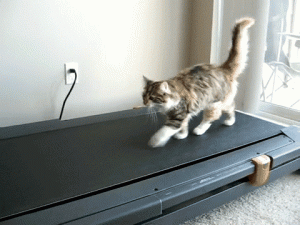Now that it is getting colder, your cat may begin to lose motivation, whether they are indoor or playing around outside. Here are some great ways for your cat to stay fit during the holiday season- (wish it were that simple for us humans!)
- Pair up exercise partners. Since a cat won’t respond to your requests to play as easily as a dog might, Jean Hofve, DVM, author and manager of LittleBigCat.com in Denver, has a simple solution to ensure that felines get their needed cat exercise: Start with two cats. “A pair of cats who get along well will get plenty of exercise through their own wrestling and chasing games. I’ve known older cats who still wrestle like kittens,” says Dr. Hofve, adding that it’s easier to get two cats at the same time than to introduce a second cat later on.
- Try a cat tower. The multi-tiered “cat towers” sold online and in pet stores are another good way to ensure th
 at your cat will have plenty of places to play and areas to climb for a good workout. Susan Nelson, DVM, an associate professor of clinical sciences at Kansas State University’s College of Veterinary Medicine in Manhattan, Kansas, suggests placing small treats in different parts of the tower to encourage climbing and playing.
at your cat will have plenty of places to play and areas to climb for a good workout. Susan Nelson, DVM, an associate professor of clinical sciences at Kansas State University’s College of Veterinary Medicine in Manhattan, Kansas, suggests placing small treats in different parts of the tower to encourage climbing and playing. - Keep plenty of toys around. Because cats tend to keep to themselves much more than dogs, the best strategy for cat workouts is to give them plenty of options in the form of toys. And these don’t have to be expensive toys from the pet store either. Dr. Nelson says you can use everyday household objects as toys to encourage cats to exercise. Think pingpong balls or balled-up pipe cleaners.
- Create a hockey rink. To make things even more interactive and fun, Nelson recommends putting a ball in a large cardboard box or the bathtub to create an instant “hockey rink” for your cat. As the ball goes flying off the walls (and the cat goes flying after it), you’ll get some laughs and your cat will get some much-needed exercise.
- Have fun with lasers. Speaking of laughs, few things will entertain you more — or have your cat moving faster — than a laser pointer on the end of a pen or leveling tool. “Laser toys are often good entertainment, but follow it up with a real toy the cat can catch to avoid fixation and frustration over never being able to catch the light beam,” says Hofve. “Be sure to never shine the beam directly into the cat’s eyes.”
- Give your cat a wand. This is a great cat exercise and a good follow-up to the laser, Hofve says. Get one of the flexible wand-style toys with a feather, mouse, or other diversion on the far end. “Interactive play with a wand or fishing-pole-type toy is fabulous exercise, usually quite funny, and extremely satisfying for the big hunter in your little cat,” Hofve says. “You can make it more challenging by running the toy up and over the sofa or up and down stairs to increase the exercise intensity.”
- Use catnip wisely. Catnip is a useful tool for getting your cat to exercise, but Hofve says it’s best to use it only in the proper situations. “Remember that not all cats respond to catnip, and of
 those that do, a few will become aggressive from catnip,” she says. “Also, never give catnip before a stressful event, such as a trip to the vet. Your vet will thank you!”
those that do, a few will become aggressive from catnip,” she says. “Also, never give catnip before a stressful event, such as a trip to the vet. Your vet will thank you!” - Get your cat on a treadmill or wheel, with supervision. Believe it or not, you can actually teach your cat to run on a treadmill for exercise, Hofve says. “It’s best to start when they are young, have lots of energy to burn, and are easy to entice with a toy,” she says. “Also, you should always supervise the cat while it’s on the treadmill.” Cats can run up to 30 miles per hour, but start slow and work up because you do not know what your cat’s speed is, Hofve says.
- Go outside. With proper training and the right equipment, you can entice your cat to walk with a leash and a harness outside, just like dogs do. “Leash-walking is great if you can get your cat to tolerate the harness and lead,” says Hofve, who favors a type of harness that is more like a soft garment for the upper part of the cat’s back, with straps built in. “Make sure the harness fits properly and can’t be wriggled out of. Young cats are easier to train, but in all cases it takes patience and perseverance.” First let them get used to the harness, then attach the leash and let them drag it, and then pick up the leash and put a little bit of pressure on it. It could take a week or two to get them really comfortable, although Hofve says they may take to it immediately.
- Create an agility course. If your cat is extremely energetic and agile, try some cat agility exercises, Hofve suggests. You might be more familiar with these challenges for dogs or horses, but cats can also enjoy this mix of speed and challenge. These programs include a number of obstacles, such as bars to jump over or tunnels to pass through, which push your cat both physically and mentally, Hofve says. She recommends researching cat agility courses online.
Happy December everyone!

